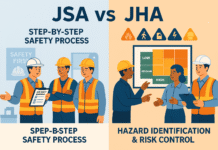
Event Tree Analysis ETA: A Complete Guide for Safety and Risk Management
Event Tree Analysis (ETA) is one of the most powerful tools in risk management and safety engineering. It is widely used in industries such as oil & gas, nuclear power, aviation, chemical plants, and construction to assess accident scenarios and develop emergency response strategies.
In this guide, we’ll cover:
- What ETA is and why it matters
- Step-by-step methodology
- Benefits and limitations
- Real-world industry applications
- Tools and software for ETA
- Practical examples with diagrams
- FAQs and exam-style questions
This article is designed to be SEO-friendly and Google Discover-ready, making it a valuable reference for professionals, students, and organizations seeking safety excellence.
What is Event Tree Analysis (ETA)?
Event Tree Analysis (ETA) is a forward-looking, inductive risk assessment technique used to analyze how an initiating event (such as equipment failure, fire outbreak, or human error) can evolve into different possible outcomes.
Unlike Fault Tree Analysis (FTA), which works backward to identify root causes, ETA works forward to examine possible consequences.
👉 Definition:
ETA is a probabilistic, graphical method that maps possible event sequences following an initiating event, showing both successful and failed safety functions, leading to final outcomes.
Why Event Tree Analysis is Important
ETA plays a critical role in modern safety management. Here’s why:
- Prepares organizations for emergencies – Predicts how accidents may escalate.
- Quantifies risk – Assigns probabilities to accident outcomes.
- Improves decision-making – Helps managers allocate resources to the most critical barriers.
- Supports compliance – Meets requirements of ISO 31000 (Risk Management) and ISO 45001 (Occupational Health & Safety Management Systems).
- Enhances learning – Visualizes accident progression for training and audits.
Key Concepts in Event Tree Analysis
Before diving into methodology, let’s clarify some essential terms:
- Initiating Event: The first failure or incident that triggers the sequence (e.g., pipe leak).
- Safety Barriers: Controls designed to stop progression (e.g., fire detection system).
- Success/Failure Paths: Branches showing whether barriers work or fail.
- End States: Final outcomes (safe shutdown, minor incident, major accident, fatality).
- Probability Assignment: Likelihood values attached to each branch.
Step-by-Step Methodology of ETA
Conducting ETA involves structured steps:
Step 1: Define the Initiating Event
Identify the starting point – such as loss of coolant in a reactor or fuel leak in a refinery.
Step 2: Identify Safety Barriers
List protective systems (alarms, sprinklers, evacuation plans, pressure relief valves).
Step 3: Develop the Event Tree
Draw a tree diagram branching out from the initiating event, with success/failure paths.
Step 4: Assign Probabilities
Use historical data, expert judgment, or reliability analysis. For example:
- Fire alarm reliability = 0.95
- Sprinkler success = 0.90
Step 5: Calculate Outcome Probabilities
Multiply along each branch to find overall likelihood of each outcome.
Step 6: Analyze and Interpret Results
Identify high-risk scenarios and decide where to strengthen barriers.
Example of Event Tree Analysis
Let’s take a fire in a chemical plant as an example:
- Initiating Event: Flammable liquid spill ignites.
- Barrier 1: Fire alarm system works or fails.
- Barrier 2: Sprinklers activate or fail.
- Barrier 3: Emergency response team acts or delays.
👉 Possible Outcomes:
- Fire suppressed quickly → No major damage.
- Sprinklers fail → Fire spreads → Major accident.
- All barriers fail → Catastrophic explosion.
Graphical Representation
ETA diagrams are typically binary trees (success/failure). For instance:
Initiating Event → Barrier 1 (Success/Fail) → Barrier 2 (Success/Fail) → Final Outcome
Each branch shows a path leading to safe states or catastrophic failures.
Advantages of Event Tree Analysis
- Forward-looking – Starts with accident and predicts outcomes.
- Quantitative + Qualitative – Combines probabilities with visual mapping.
- Simple Visualization – Easy to explain in audits, training, and board meetings.
- Supports Decision-Making – Helps managers prioritize investments in safety systems.
Limitations of Event Tree Analysis
- Data Dependency – Requires accurate failure probability data.
- Complexity – Large systems can create massive trees.
- Assumes Independence – May oversimplify correlated failures.
- Focus on Known Scenarios – Cannot predict unknown failure modes.
ETA vs. Fault Tree Analysis (FTA)
| Feature | ETA | FTA |
|---|---|---|
| Direction | Forward (from cause to consequence) | Backward (from consequence to root cause) |
| Use Case | Outcome analysis | Cause analysis |
| Focus | Safety system performance | Failure logic |
| Diagram | Branching tree | Logic gates |
👉 Many organizations use ETA and FTA together for comprehensive safety assessments.
Real-World Applications of ETA
ETA is widely applied in high-risk industries:
- Nuclear Power: Reactor safety, cooling system failures.
- Oil & Gas: Blowout prevention, refinery fire analysis.
- Aviation: Engine failure, evacuation system reliability.
- Construction: Crane collapse, fire spread in high-rise buildings.
- Chemical Plants: Toxic gas release scenarios.
ETA in Occupational Safety and Health (OSH)
Workplace health and safety officers use ETA to:
- Plan emergency response drills
- Assess fire protection systems
- Evaluate PPE effectiveness
- Improve lockout/tagout procedures
Tools and Software for ETA
Modern safety professionals use specialized tools:
- RiskSpectrum® – Widely used in nuclear safety.
- Reliability Workbench – Integrates FTA and ETA.
- CAFTA (Computer Aided Fault Tree Analysis)
- BowTieXP – Links ETA with bowtie analysis.
Event Tree Analysis Example (Numerical)
Let’s calculate a simplified ETA for fire suppression:
- Fire alarm success = 0.9
- Sprinkler success = 0.8
- Emergency response success = 0.85
👉 Path 1 (all succeed): 0.9 × 0.8 × 0.85 = 0.612 (Safe outcome)
👉 Path 2 (sprinkler fails, response works): 0.9 × 0.2 × 0.85 = 0.153 (Controlled fire)
👉 Path 3 (all fail): 0.1 × 0.2 × 0.15 = 0.003 (Catastrophic accident)
This shows that while catastrophic accidents are rare, they cannot be ignored.
Integration with Other Risk Tools
- Bow-Tie Analysis – Combines ETA (right side) and FTA (left side).
- Quantitative Risk Assessment (QRA) – Uses ETA to model accident probabilities.
- Hazard and Operability Study (HAZOP) – Provides initiating events for ETA.
Best Practices for ETA
- Use Accurate Data – Reliability databases, past accident reports.
- Keep Diagrams Simple – Avoid unnecessary branching.
- Review Regularly – Update after equipment changes or incidents.
- Combine with FTA – For stronger risk management.
- Communicate Results Clearly – Present to management in risk-based format.
FAQs on Event Tree Analysis
Q1. Is ETA only for high-risk industries?
No. ETA can be applied in any workplace for emergency planning.
Q2. How is ETA different from risk matrix?
Risk matrices are qualitative; ETA provides probabilistic pathways.
Q3. Can ETA predict black swan events?
Not exactly. ETA works best with known initiating events.
External References
FMEA (Failure Modes & Effects Analysis)
Hierarchy of Controls in Risk Assessment
Designing a 3×3 vs 5×5 Risk Matrix
Conclusion
Event Tree Analysis (ETA) is a powerful forward-looking tool that helps organizations predict accident consequences, quantify risks, and improve safety barriers. While it requires accurate data and careful interpretation, ETA remains a cornerstone of modern safety management.
For professionals in oil & gas, aviation, nuclear, construction, and chemical industries, ETA provides a structured pathway to prepare for emergencies, protect people, and reduce losses.
























